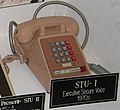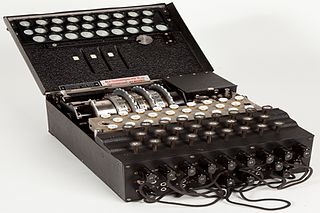
The Enigma machine is a cipher device developed and used in the early- to mid-20th century to protect commercial, diplomatic, and military communication. It was employed extensively by Nazi Germany during World War II, in all branches of the German military. The Enigma machine was considered so secure that it was used to encipher the most top-secret messages.

The National Security Agency (NSA) is an intelligence agency of the United States Department of Defense, under the authority of the Director of National Intelligence (DNI). The NSA is responsible for global monitoring, collection, and processing of information and data for foreign and domestic intelligence and counterintelligence purposes, specializing in a discipline known as signals intelligence (SIGINT). The NSA is also tasked with the protection of U.S. communications networks and information systems. The NSA relies on a variety of measures to accomplish its mission, the majority of which are clandestine. The NSA has roughly 32,000 employees.

William Frederick Friedman was a US Army cryptographer who ran the research division of the Army's Signal Intelligence Service (SIS) in the 1930s, and parts of its follow-on services into the 1950s. In 1940, subordinates of his led by Frank Rowlett broke Japan's PURPLE cipher, thus disclosing Japanese diplomatic secrets before America's entrance into World War II.

Abraham Sinkov was a US cryptanalyst. An early employee of the U.S. Army's Signal Intelligence Service, he held several leadership positions during World War II, transitioning to the new National Security Agency after the war, where he became a deputy director. After retiring in 1962, he taught mathematics at Arizona State University.

Agnes Meyer Driscoll, known as "Miss Aggie" or "Madame X'", was an American cryptanalyst during both World War I and World War II and was known as "the first lady of naval cryptology."

David Kahn was an American historian, journalist, and writer. He wrote extensively on the history of cryptography and military intelligence.
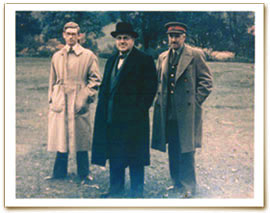
Brigadier John Hessell Tiltman, was a British Army officer who worked in intelligence, often at or with the Government Code and Cypher School (GC&CS) starting in the 1920s. His intelligence work was largely connected with cryptography, and he showed exceptional skill at cryptanalysis. His work in association with Bill Tutte on the cryptanalysis of the Lorenz cipher, the German teleprinter cipher, called "Tunny" at Bletchley Park, led to breakthroughs in attack methods on the code, without a computer. It was to exploit those methods, at extremely high speed with great reliability, that Colossus, the first digital programmable electronic computer, was designed and built.

The Central Security Service (CSS) is a combat support agency of the United States Department of Defense which was established in 1972 to integrate the National Security Agency (NSA) and the Service Cryptologic Components (SCC) of the United States Armed Forces in the field of signals intelligence, cryptology, and information assurance at the tactical level. In 2002, the CSS had approximately 25,000 uniformed members. It is part of the United States Intelligence Community.

The bombe was an electro-mechanical device used by British cryptologists to help decipher German Enigma-machine-encrypted secret messages during World War II. The US Navy and US Army later produced their own machines to the same functional specification, albeit engineered differently both from each other and from Polish and British bombes.
The Signal Intelligence Service (SIS) was the United States Army codebreaking division through World War II. It was founded in 1930 to compile codes for the Army. It was renamed the Signal Security Agency in 1943, and in September 1945, became the Army Security Agency. For most of the war it was headquartered at Arlington Hall, on Arlington Boulevard in Arlington, Virginia, across the Potomac River from Washington (D.C.). During World War II, it became known as the Army Security Agency, and its resources were reassigned to the newly established National Security Agency (NSA).
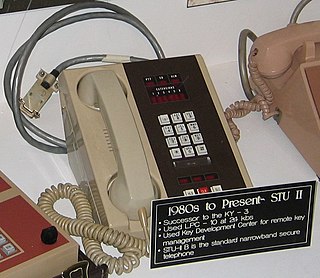
The STU-II is a secure telephone developed by the U.S. National Security Agency. It permitted up to six users to have secure communications, on a time-shared basis. It was made by ITT Defense Communications, Nutley, New Jersey. An OEM partner was Northern Telecom.
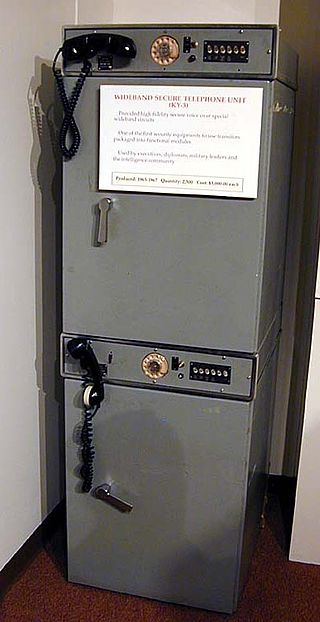
The KY-3 (TSEC/KY-3) is a secure telephone system developed by the U.S. National Security Agency in the early 1960s. It was one of the first widely accepted voice voice encryption systems. The "TSEC" prefix to the model number indicates NSA's Telecommunications Security nomenclature system.

The National Cryptologic University (NCU) is a school within the National Security Agency that provides training to members of the United States Intelligence Community.
The NSA/CSS Texas Cryptologic Center (TCC), also known as the Texas Cryptology Center, Texas Cryptographic Center or NSA Texas, is a satellite campus at the Medina Annex, Lackland Air Force Base, San Antonio, Texas, operated by the U.S. National Security Agency (NSA). It is adjacent to the former Medina National Stockpile Site. TCC conducts signals intelligence, cyberwarfare operations and cybersecurity operations.

Joseph Numa Wenger was a Rear-Admiral of the United States Navy who served as the first Deputy Director of the Armed Forces Security Agency (AFSA), and later as the first Vice Director of the National Security Agency, from December 1952 to November 1953, after the separate divisions of the AFSA merged into the NSA. Wenger was one of the leaders responsible for the development of the NSA. He was a native of Patterson, Louisiana.
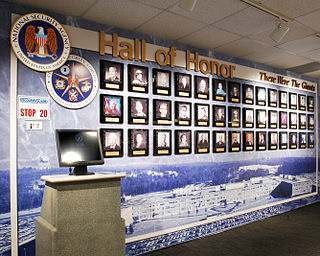
The Hall of Honor is a memorial at the National Security Agency headquarters in Fort Meade, Maryland. It honors individuals who rendered distinguished service to American cryptology.
The United States' National Security Agency (NSA), an intelligence agency of the federal government, publishes many documents on the history and technology of cryptology, cryptography, and cryptanalysis through various publications.
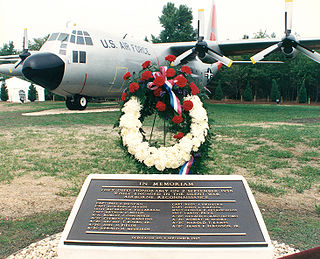
The United States National Vigilance Park (NVP) was a memorial to the military servicemen who participated in aerial reconnaissance during the Cold War. Dedicated on September 2, 1997, NVP was located just one block from the National Security Agency (NSA) headquarters at Fort George G. Meade, Maryland. It was previously open 24 hours a day for viewing. Military events connected with the Intelligence Community and/or personnel stationed at Ft. Meade or working at NSA were formerly scheduled through the National Cryptologic Museum (NCM), which is just one block west of the former park.
The Georgia Cryptologic Center (GCC) or NSA Georgia is a U.S. National Security Agency (NSA) and Central Security Service (CSS) facility located within Fort Eisenhower, located outside of Augusta, Georgia. The 604,000 sq ft (56,100 m2) facility opened on March 5, 2012, at a cost of $286 million. The GCC's facilities have the capacity to employ up to 4,000 personnel. Its primary focus is on signals intelligence intercepts from Europe, the Middle East, and North Africa. The facility is known by the codename "Sweet Tea".

Mary Caroline "Polly" Hughes Budenbach was an American cryptanalyst. She won the Federal Woman's Award in 1969, and was posthumously inducted into the NSA Hall of Honor in 2017.





